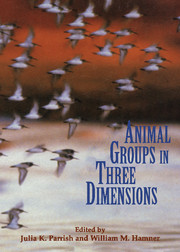Book contents
- Frontmatter
- Contents
- List of contributors
- Acknowledgments
- 1 Introduction – From individuals to aggregations: Unifying properties, global framework, and the holy grails of congregation
- Part one Imaging and measurement
- Part two Analysis
- Part three Behavioral ecology and evolution
- 11 Is the sum of the parts equal to the whole: The conflict between individuality and group membership
- 12 Inside or outside? Testing evolutionary predictions of positional effects
- 13 Costs and benefits as a function of group size: Experiments on a swarming mysid Paramesopodopsis rufa Fenton
- 14 Predicting the three-dimensional structure of animal aggregations from functional considerations: The role of information
- 15 Perspectives on sensory integration systems: Problems, opportunities, and predictions
- Part four Models
- References
- Subject index
- Taxonomic index
15 - Perspectives on sensory integration systems: Problems, opportunities, and predictions
from Part three - Behavioral ecology and evolution
Published online by Cambridge University Press: 01 June 2010
- Frontmatter
- Contents
- List of contributors
- Acknowledgments
- 1 Introduction – From individuals to aggregations: Unifying properties, global framework, and the holy grails of congregation
- Part one Imaging and measurement
- Part two Analysis
- Part three Behavioral ecology and evolution
- 11 Is the sum of the parts equal to the whole: The conflict between individuality and group membership
- 12 Inside or outside? Testing evolutionary predictions of positional effects
- 13 Costs and benefits as a function of group size: Experiments on a swarming mysid Paramesopodopsis rufa Fenton
- 14 Predicting the three-dimensional structure of animal aggregations from functional considerations: The role of information
- 15 Perspectives on sensory integration systems: Problems, opportunities, and predictions
- Part four Models
- References
- Subject index
- Taxonomic index
Summary
It is more pleasant to present great ideas than to engage in painstaking collection of data.
Tjeerd van AndelIntroduction
There is something captivating about large groups of animals moving swiftly and synchronously. A flock of pigeons wheeling over a city park or a silvery cloud of anchovies at the Monterey Bay Aquarium is fascinating and beautiful to people far removed from those of us who study and think critically about animal aggregations and schools. Although scientists have been interested in animal group dynamics for many years, these phenomena have proved difficult to manage quantitatively. Until recently, much that was written about school structure and function was of necessity based on the analysis of very small groups or upon rather subjective or rational arguments.
A pertinent example of the latter is Hamilton's 1971 model for animal aggregation, the “Selfish Herd.” This results from a progression of logic that predicts that individuals will seek the interior of a group because they are safer there than they would be at the edge. Given his assumptions, the frogs in Hamilton's thought experiment hop into groups and thereby improve their odds. At least one of those frogs will lose due to its lack of nearby neighbors. The “selfish herd” has rightly been an important part of thinking about predators and schooling prey for two decades.
But models must be tested against nature and the naturalists among us know that there's more to it than jockeying for the inside track. Among the city pigeons, recognizable individuals change relative positions frequently and move throughout the flock.
- Type
- Chapter
- Information
- Animal Groups in Three DimensionsHow Species Aggregate, pp. 225 - 244Publisher: Cambridge University PressPrint publication year: 1997
- 10
- Cited by



